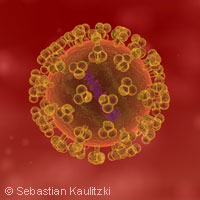New assassin cells detect HIV's many disguises
Researchers from the UK and US have engineered a white blood cell that is able to recognise immune-system-evading HIV-1 strains. The team's new 'assassin cells' may cripple the well-disguised virus, possibly slowing or preventing the onset of AIDS in infected individuals. The findings are published online in the journal Nature Medicine. In 2007 an estimated 33 million people worldwide were living with HIV. Drug resistance to anti-retroviral treatments, which are effective in delaying the onset of AIDS, is increasingly becoming a problem. Finding new and more cost-effective treatments against this destructive virus is of utmost importance and high on the political agenda. HIV replicates and mutates rapidly, drawing on an arsenal of strategies to escape detection from the immune system. One of its most effective T-cell evasion strategies is its capacity to hide its 'molecular fingerprints': the tell-tale antigens that viruses normally display on the surface of infected cells. Normally, these fingerprints (called epitopes) are identified by T cells, which in turn trigger an immune response. 'When the body mounts a new killer T-cell response to HIV,' explained Professor Andy Sewell of Cardiff University in the UK, 'the virus can alter the molecular fingerprint that these cells are searching for in just a few days. It's impossible to track and destroy something that can disguise itself so readily. As soon as we saw over a decade ago how quickly the virus can evade the immune system we knew there would never be a conventional vaccine for HIV.' The researchers concentrated their efforts on devising a 'disguise detection' strategy in order to detect and weaken (or possibly destroy) HIV-1. Working with an antigen called SL9 (which causes HIV to mutate, reducing its fitness), they engineered a killer T-cell receptor that successfully recognised all of the different disguises that the virus used to evade detection. This receptor was attached to killer T-cells, which were then able to destroy HIV-infected cells in culture. 'The T-cell receptor is nature's way of scanning and removing infected cells - it is uniquely designed for the job but probably fails in HIV because of the tremendous capability of the virus to mutate,' according to Dr Bent Jakobsen of the UK-based company that owns the new technology. 'In the face of our engineered assassin cells, the virus will either die or be forced to change its disguises again, weakening itself along the way,' said Professor Sewell, who added that the new cells would be more likely to weaken than to kill the virus. 'Even if we do only cripple the virus, this will still be a good outcome as it is likely to become a much slower target and be easier to pick off. Forcing the virus to a weaker state would likely reduce its capacity to transmit within the population and may help slow or even prevent the onset of AIDS in individuals.' Clinical trials using the engineered killer T-cells are planned for next year in the US, pending regulatory approval. According to Professor Rodney Phillips of the University of Oxford, where the collaborative research effort first began in 2003, 'Until now no-one has been able to clear the virus naturally. Immune cells modified in the laboratory in this way provide a test as to whether we can enhance the natural response in a useful and safe way to clear infected cells. If successful, the technology could be applied to other infectious agents.' 'Now we have managed to engineer a receptor that is able to detect HIV's key fingerprints and is able to clear HIV infection in the laboratory,' said Dr Jakobsen. 'If we can translate those results in the clinic, we could at last have a very powerful therapy on our hands.'
Countries
United Kingdom



